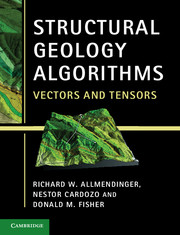Book contents
- Frontmatter
- Contents
- Preface
- Chapter One Problem solving in structural geology
- Chapter Two Coordinate systems, scalars, and vectors
- Chapter Three Transformations of coordinate axes and vectors
- Chapter Four Matrix operations and indicial notation
- Chapter Five Tensors
- Chapter Six Stress
- Chapter Seven Introduction to deformation
- Chapter Eight Infinitesimal strain
- Chapter Nine Finite strain
- Chapter Ten Progressive strain histories and kinematics
- Chapter Eleven Velocity description of deformation
- Chapter Twelve Error analysis
- References
- Index
Preface
Published online by Cambridge University Press: 05 June 2012
- Frontmatter
- Contents
- Preface
- Chapter One Problem solving in structural geology
- Chapter Two Coordinate systems, scalars, and vectors
- Chapter Three Transformations of coordinate axes and vectors
- Chapter Four Matrix operations and indicial notation
- Chapter Five Tensors
- Chapter Six Stress
- Chapter Seven Introduction to deformation
- Chapter Eight Infinitesimal strain
- Chapter Nine Finite strain
- Chapter Ten Progressive strain histories and kinematics
- Chapter Eleven Velocity description of deformation
- Chapter Twelve Error analysis
- References
- Index
Summary
Preface
Structural geology has been taught, largely unchanged, for the last 50 years or more. The lecture part of most courses introduces students to concepts such as stress and strain, as well as more descriptive material like fault and fold terminology. The lab part of the course usually focuses on practical problem solving, mostly traditional methods for describing quantitatively the geometry of structures. While the lecture may introduce advanced concepts such as tensors, the lab commonly trains the student to use a combination of graphical methods, such as orthographic or spherical projection, and a variety of plane trigonometry solutions to various problems. This leads to a disconnect between lecture concepts that require a very precise understanding of coordinate systems (e.g., tensors) and lab methods that appear to have no common spatial or mathematical foundation. Students have no chance to understand that, for example, seemingly unconnected constructions such as down-plunge projections and Mohr circles share a common mathematical heritage: They are both graphical representations of coordinate transformations. In fact, it is literally impossible to understand the concept of tensors without understanding coordinate transformations. And yet, we try to teach students about tensors without teaching them about the most basic operations that they need to know to understand them.
The basic math behind all of these seemingly diverse topics consists of linear algebra and vector operations. Many geology students learn something about vectors in their first two semesters of college math, but are seldom given the opportunity to apply those concepts in their chosen major. Fewer students have learned linear algebra, as that topic is often reserved for the third or fourth semester math. Nonetheless, these basic concepts needed for an introductory structural geology course can easily be mastered without a formal course; we assume no prior knowledge of either. On one level, then, this book teaches a consistent approach to a subset of structural geology problems using linear algebra and vector operations. This subset of structural geology problems coincides with those that are usually treated in the lab portion of a structural geology course.
- Type
- Chapter
- Information
- Structural Geology AlgorithmsVectors and Tensors, pp. ix - xiiPublisher: Cambridge University PressPrint publication year: 2011



